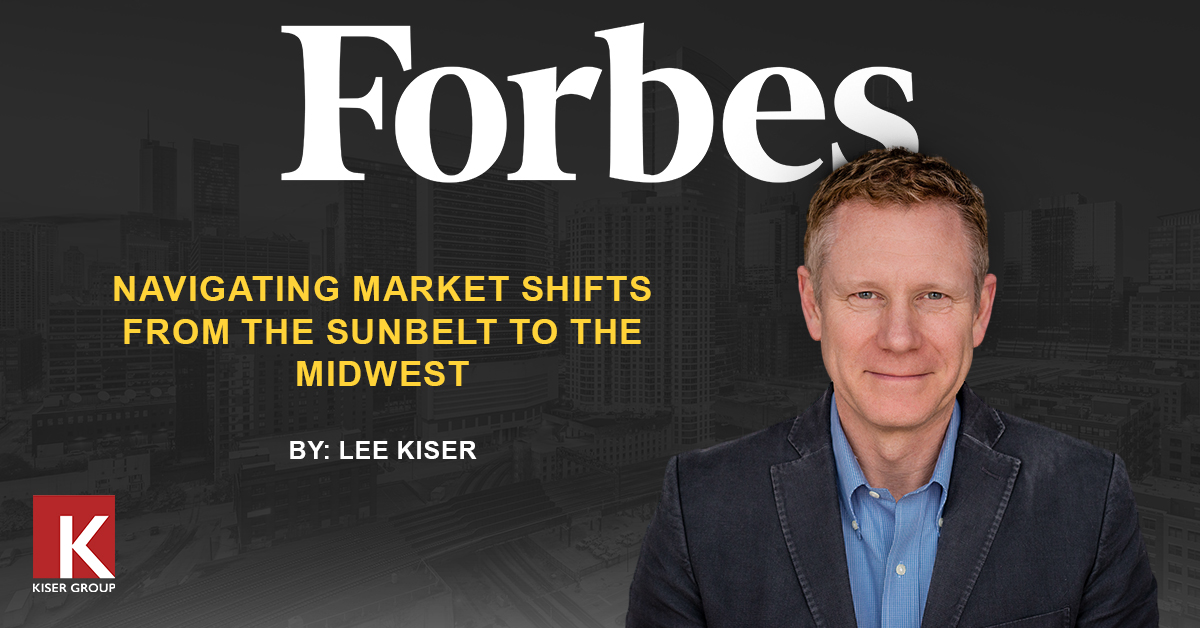02.15.24
Navigating Market Shifts From The Sunbelt To The Midwest

If you’ve followed real estate news lately, you’ve probably been left with the impression that the sky is falling. WeWork, with its notorious founder and publicity surrounding its saga, has filed for bankruptcy. Interest rates are the highest they’ve been in decades. Since stay-at-home orders from the Covid pandemic, a precipitous change has occurred in where we work, leading to higher office building vacancy rates. CBRE, the world’s largest commercial real estate services firm, has seen a stock price drop of almost 50% from its all-time high in 2022, with many other peer companies experiencing similar results. Almost every other week another notable real estate owner seems to be in the news due to a large foreclosure of their portfolio (paywall).
While all of these aforementioned statements are facts, there’s more than meets the eye that affects the health of the market. In several instances, these generalizations can feel as if they are bringing down the entire market. I know this not to be true, as there are several geographic and asset-specific characteristics that have weathered the storm and in some cases are bucking the national trends and continue to produce. Below, I will break down a few of those instances.
The Darling Of The Last Decade: The Sunbelt Market
By and large, several states (and their metropolitan areas) have benefitted tremendously in the last decade from an influx of economic activity. States like Texas have seen several jobs—and subsequently workers—move there from more expensive areas throughout the country. In turn, these “Sunshine” States as they’re colloquially referred to, have benefitted from tremendous growth in real estate. With increasing populations and job growth, developers from several asset classes—multifamily, office, industrial and retail (to name a few)—have been largely successful at building new structures to absorb this growing demand. Rent growth in these areas has remained a clip ahead of non-Sunbelt markets in past years. With this strong performance, several of these markets saw an influx of investor activity—groups that were hoping to cash in on the consistent rental growth of a bevy of new arrivals—all in a very low interest rate environment.
Sunbelt Markets Get Caught And Take A Back Seat
As a result of this low interest rate environment and increased competition from several investors bidding up the same locations, building sale prices crept higher and higher. It wasn’t long before several of these markets continuously led the country to have the lowest cap rates. A cap rate is determined by dividing a building’s net operating income by its final purchase price. Essentially, the higher a building’s purchase price, the lower its cap rate. With cap rates, particularly in the multifamily and apartment sector, pushing lower and lower, investors purchased buildings at sky-high valuations resulting in 4%—or lower—cap rates. Essentially, a 4% cap rate implies that a building purchased with all cash is expected to generate a 4% return based on the building’s net operating income. While those returns are not ideal in the long run, many times they are offset by rising rental rates outpacing expenses at a building (i.e., increasing their profit). This story largely played true throughout the Sunbelt for some time.
The Midwest’s Time To Shine
Fast forward to our current environment: Interest rates are the highest they’ve been in decades and rose at a precipitous clip in the last 18 months, catching many off guard. The influx of jobs and population growth—mixed with a large supply of new construction coming online—in several Sunbelt markets has slowed. All of this has led to multifamily building owners that have begun to see flat or lower year-over-year rent growth in the Sunbelt markets.
As a result, we’re now seeing several markets that primarily took a back seat in the last decade, begin to have their moment in the spotlight. Several Midwest markets have led the nation in rent growth over the last year. Chicago’s MSA has led the nation in rent growth—tripling the national average. While these markets did not experience the same rates of growth as several Sunbelt markets over the last decade, their “steady-eddy’’ growth may just prove to be their most notable benefit. As a result of more consistent growth, several Midwestern markets have largely dodged much of the distress seen in the Sunbelt and other growth regions where valuations were pushed to unsustainable prices.
Implications For 2024
To me, there does not appear to be any end in sight to the enormous pipelines of large apartment complexes being built in the south and southwest areas of the country. I expect the 2024 calendar year to easily surpass 2023’s records in new supply. The South is expecting over 350,000 of these units, with Dallas, Austin, Atlanta, Houston and Charlotte all expecting to add over 20,000 units each in 2024 alone. As a result, many of the woes for builders and owners in the Sunbelt (mostly in the form of lower occupancy and flat rent growth) may persist given additional supply in the market. Conversely, there are opportunities for rent growth to resume should population in-flows keep pace with or exceed the supply of housing.
With one of the lowest pipelines, it seems the Midwest will remain supply constrained. Comparatively, the steady-eddy Midwest is expecting to see only 62,000 new units (Chicago at 8,100 units, for comparison). While there are many ways to interpret this figure and its comparison to the ultra-growth in the South and West, what is clear is that a smaller supply pipeline will not be as impactful of a factor in the Midwest as it is in the South and Southwest.
While the Midwest has a plethora of barriers to entry—from a lack of population growth, local politics, weather/year-round lifestyle amenities—the Sunbelt has thrived in the last decade as the antidote. However, there may eventually be a break-even point where the sun eventually does set on the most fruitful opportunities for apartment developers, and the risk of being over-built becomes too great. Should that Southern music continue to slow down, developers may once again draw their gaze to the pastures of the Midwest for future opportunities.
Click here to read the full story by Forbes.
